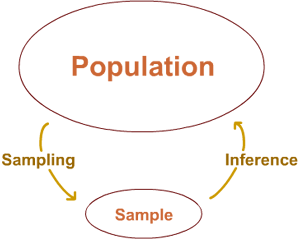- Descriptive statistics are functions of the data that are intrinsically interesting in describing some feature of the data. Classic descriptive statistics include mean, min, max, standard deviation, median, skew, kurtosis.
- Inferential statistics are a function of the sample data that assists you to draw an inference regarding an hypothesis about a population parameter. Classic inferential statistics include z, t, χ2, F-ratio, etc.
There are two major divisions of inferential statistics:
- A confidence interval gives a range of values for an unknown parameter of the population by measuring a statistical sample. This is expressed in terms of an interval and the degree of confidence that the parameter is within the interval.
- Tests of significance or hypothesis testing tests a claim about the population by analyzing a statistical sample. By design there is some uncertainty in this process. This can be expressed in terms of a level of significance.
Example-
Say we want to assess the effects of Vitamin C on cognitive ability in adults. Rather than using the entire population of all adults in India, we select a random sample of 1000 adults, one-half consume 500mg of vitamin C daily for 4 weeks and the other one-half do not.
Say that the average cognitive ability for adults who do not consume vitamin C is M = 50 (higher numbers indicate better cognitive ability).The average cognitive ability for those adults who consumed vitamin C during the past month is M = 65.
The data indicate a 15-point difference between the two samples.
There are two possible interpretations:
1) There is no “real” difference between the two groups (suggesting the mean differences are simply due to chance factors — i.e., sampling error).
OR
2) The sampling data reflect a “true” difference between the two groups.
The goal of inferential statistics is to help researchers decide between the two interpretations.
Inferential statistics begins with actual data (sample data) from the experiment above and ends with a probability statement (i.e., the probability of obtaining data like those above if there is no effect of vitamin C on cognitive ability in the population)
If the probability is very small (p<.05) that the mean differences were due to chance factors, we can conclude that vitamin C does affect cognitive ability. That is, the observed data are not what would be expected by chance alone.

